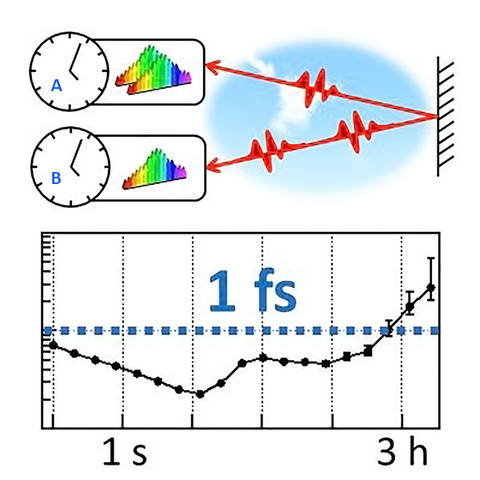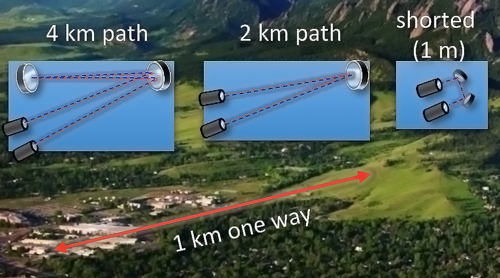
NIST researchers have devised a way to synchronize the time of two different clocks – separated by as much as 4 km of open, turbulent air – to within a few millionths of a billionth of a second using optical light pulses. That constitutes a thousand-fold improvement in sensitivity compared to the best conventional methods that connect and control clocks at radio frequencies.
A network of such clocks, synchronized on a femtosecond (fs, 10-15 s) time scale, could enable dramatic advances in tests of general relativity, coherent sensing, the future redefinition of the second, and even such exotic applications as searches for dark matter.*
"The scientific motivations for the world's best clocks often rely on the ability to compare or even synchronize the clocks," says Laura Sinclair, one of the team of scientists in NIST's Physical Measurement Laboratory who invented and tested the system. "If we want to be able to use 'time networks' for sensing, relativistic tests, precision navigation or other applications we have yet to imagine, we need to be able to make the connection between clocks without reducing the performance."
Worldwide, today's master clocks typically have operating frequencies of billions of cycles per second, in the microwave range of the radio-frequency spectrum. In addition, today's distribution of master clock signals also relies on the microwave range of the radio-frequency spectrum. While this mature technology allows for time to be distributed across vast distances, time can only be transferred at the level of picoseconds (ps, 10-12 s).
Clocks located at remote sites can thus only be forced to agree on the time (i.e., synchronized) with the master clock to picoseconds. But picoseconds are far too coarse a time scale for many pressing needs in modern science. Experts expect that the next generation of time standards will use optical frequencies at hundreds of trillions of cycles per second. This means that tomorrow's master clocks can support time networks at the femtosecond (fs, 10-15 s) level if only the signals can be faithfully moved out of the lab.
Synchronizing optical clocks within femtoseconds over open space (that is, without connecting them by optical fiber, which is impractical for a number of critical mobile and field applications) poses a formidable challenge. It "requires real-time measurements of the absolute time offset between clocks, real-time communications between sites, and real-time adjustment of the synchronized clock, all with femtosecond-level precision," the NIST team writes in Physical Review X. (See also the commentary at http://physics.aps.org/articles/v9/51.)
The researchers achieved that goal using an experimental setup that consists of a local Clock A (the master) and a remote Clock B (to be synchronized), separated by 4 km of turbulent air.**
Each clock contains an independent, on-board timescale consisting of a train of sharp, coherent, identically spaced optical pulses. This train of pulses is output from a special laser, called a frequency comb,*** that is referenced to an underlying optical cavity. The pulses are spaced by 5 nanoseconds (ns) with a timing deviation (or "jitter") of only 1 or 2 fs, with respect to an underlying optical oscillator. These labeled pulses can be thought of as the "ticks" of the clock. When the pulses with the same label from Clock A and B overlap at a chosen reference plane, the system is synchronized as the clocks are ticking at the same rate and read the same time.

"Remarkably, the clocks can be synchronized across the air despite turbulence and the occasional complete blocking of the beam," Sinclair said. "This success relies on the fact that the atmosphere is reciprocal. We borrow from the microwave community and send our signals both directions. By taking the difference of the arrival time of the pulses at site A and site B, we cancel out all the fluctuations in arrival time due to turbulence and the slow sway of the building.
"In fact, we can quantify how reciprocal the atmosphere is for our measurements: The path going from site A to site B is measured to be the same as the path going from site B to site A to within an error of 70 nanometers despite the path length changing by 10 cm." The researchers have found no evidence that increasing the path length to longer distances degrades the measurement; that holds out hope for extensions of this technique to very long distances.
The occasional interruption of the laser link requires an approach which measures the time difference between the clocks rather than the more conventional method for optical clocks of monitoring the clocks' frequency difference. "Measuring time at the femtosecond level is challenging," Sinclair explains. "You can't just directly measure the pulse arrival time with femtosecond-resolution on a conventional detector."
The researchers had to add a second frequency comb (called a transfer comb) to site A, to be able to detect the timing information. This transfer comb is connected to the same optical cavity as the Clock A comb but ticks at a slightly different rate. The overlap between the transfer comb pulses and the Clock A and B comb pulses provides a measurement of the underlying pulse arrival times. "The cool thing is that this overlap is easy to measure because you just use a single photodetector that sees a spike every 500 microseconds (µs, 10-6 s)."
In repeated trials, the scientists found that the clocks' synchronized timescales deviated by only 1 fs over periods as long as 100 minutes, and by no more than 40 fs over two days. Remarkably, the pulse trains can be detected when each pulse contains as few as 80 photons.
In related work in the most recent issue of Optica, the same researchers have demonstrated that the remote clock can be based on a much more compact and robust quartz oscillator, rather than an optical cavity, which should greatly improve the size, weight, power, and robustness of the remote clock.
In both experiments, the clocks were in fixed locations. "But when you think about how these systems might be used in real-world applications, you have to be able to handle motion too," Sinclair says. "For us, a huge challenge going forward is how to extend our system to a moving platform. We are excited about overcoming this challenge to support a broader range of real world applications."
* See "Hunting for topological dark matter with atomic clocks," A. Derevianko and M. Pospelov, 10 Nature Physics (2014) for an example of a proposal to use clocks to search for dark matter.
** To conduct their experiment, the team placed the clocks next to each other atop a building at NIST's Boulder, Colo., facility. The signals that each clock sent to the other were bounced off a 53 cm mirror on the nearby foothills. The more round-trips the reflected light took before returning, the longer the effective distance between the clocks. The team demonstrated the synchronization remained even if the path length was varied between 0, 2, and 4 km in real time.
*** For a discussion of frequency combs, see this page.

